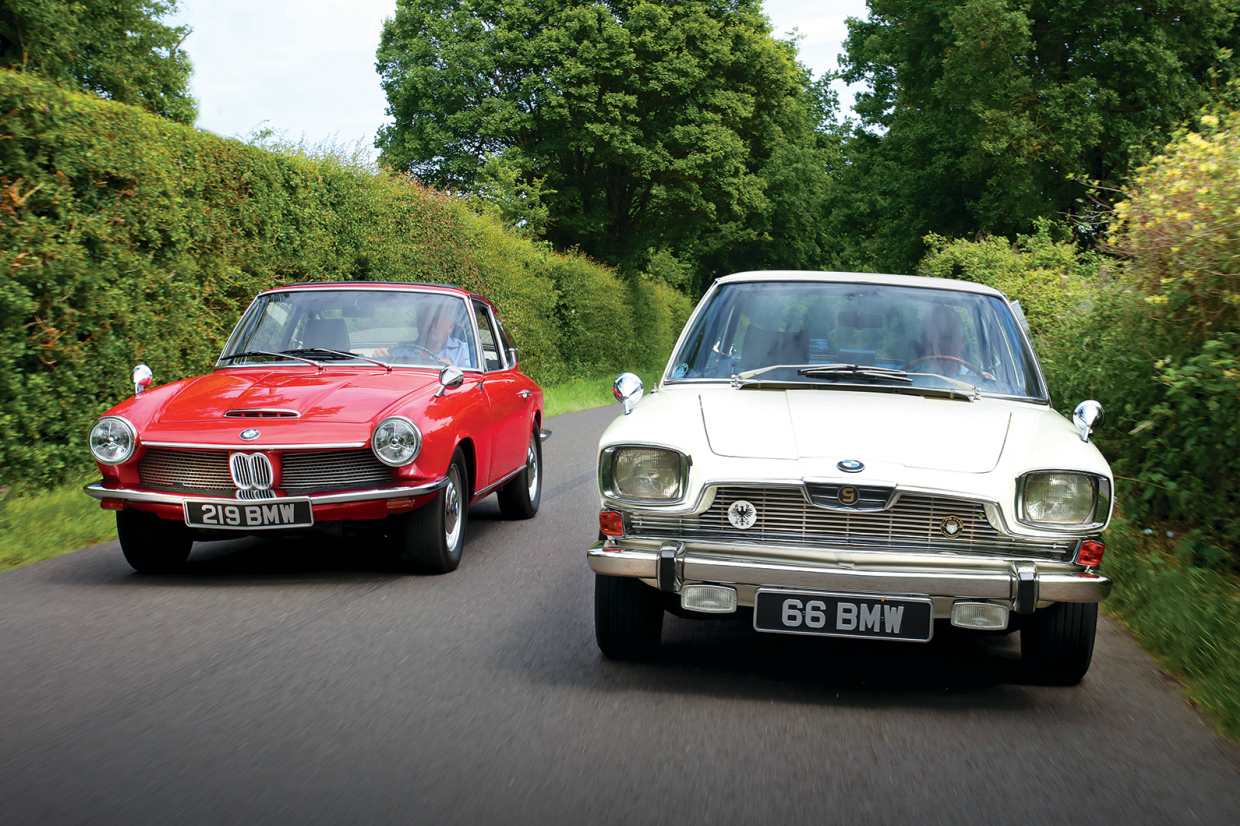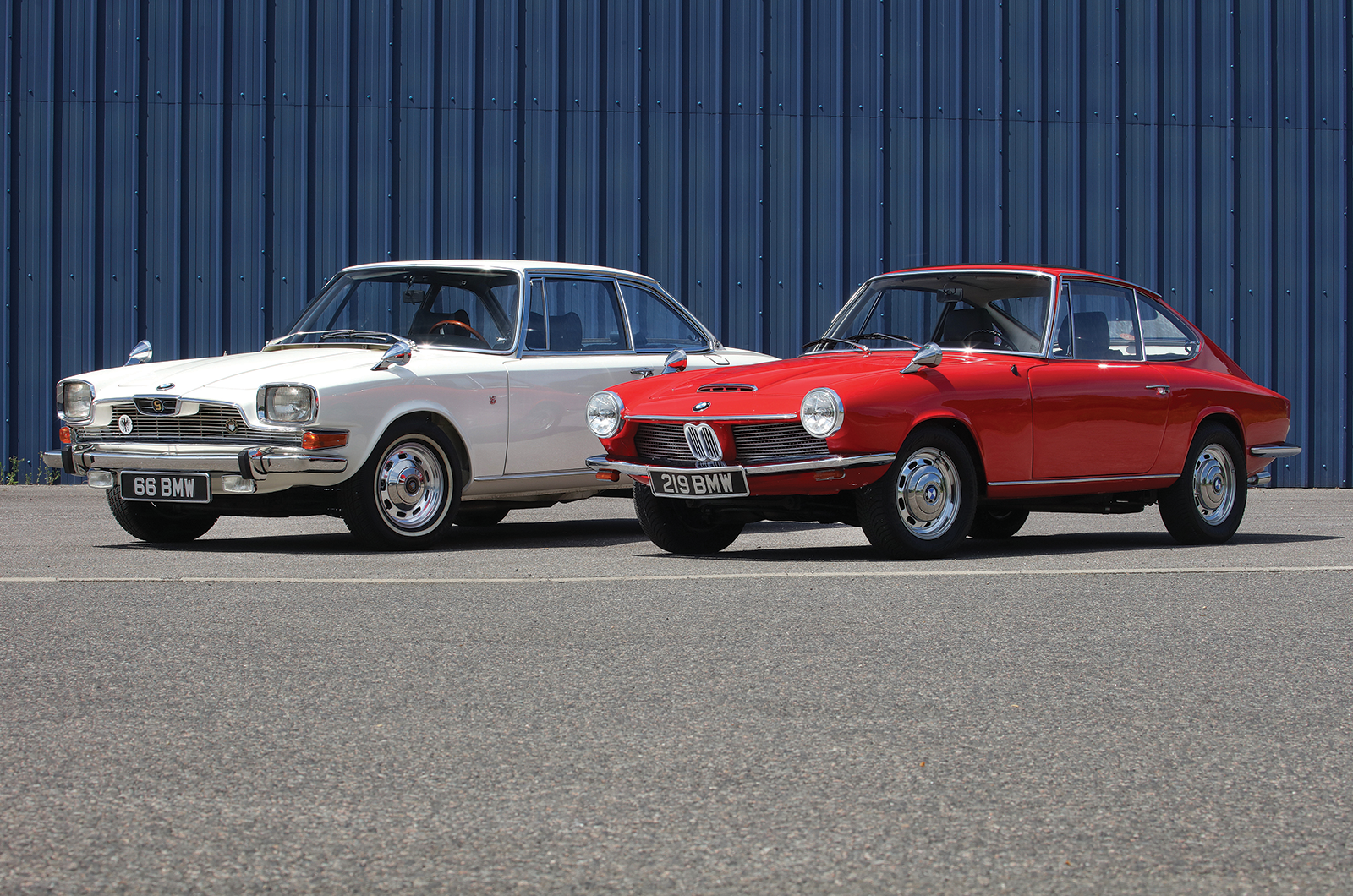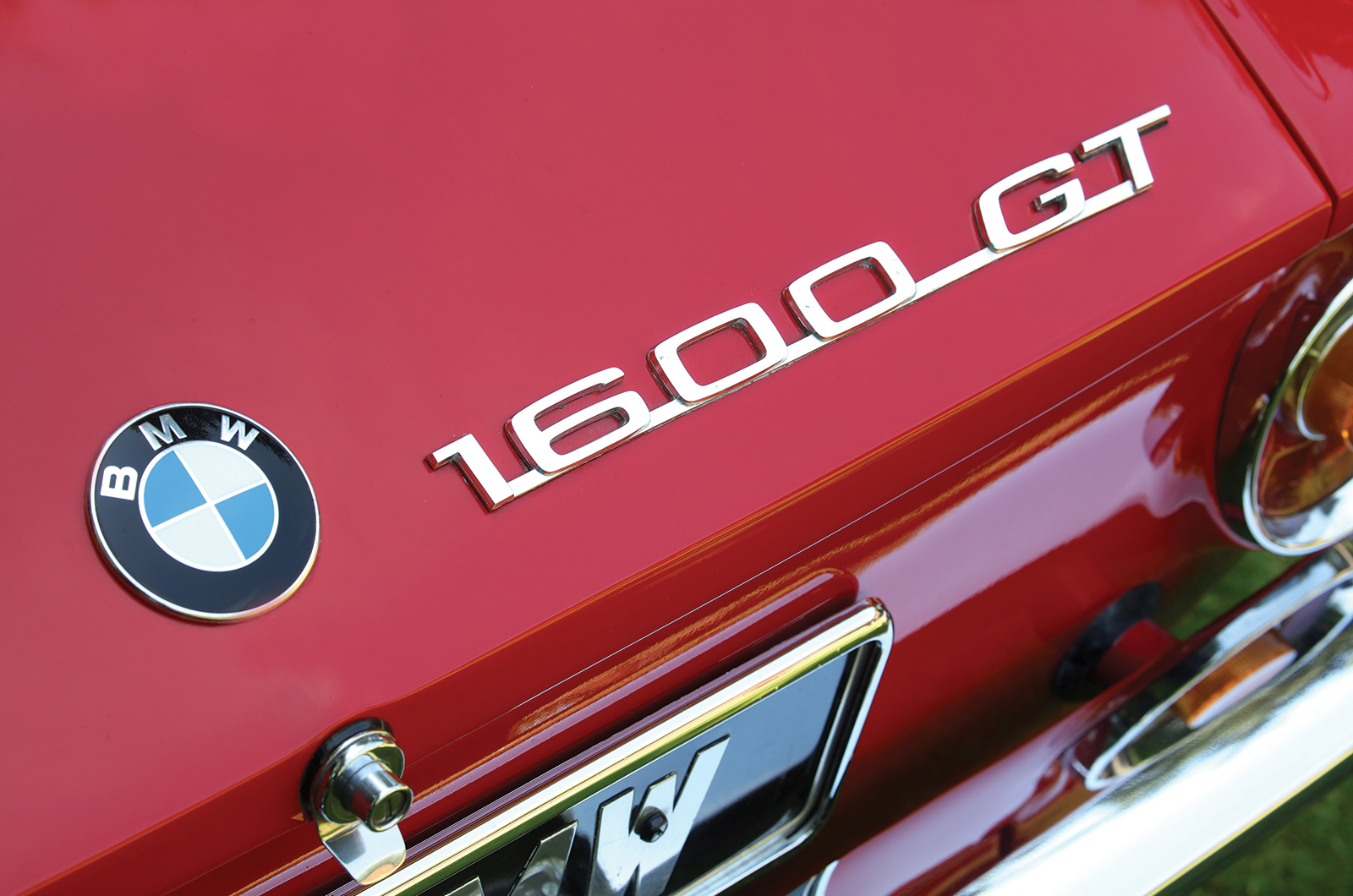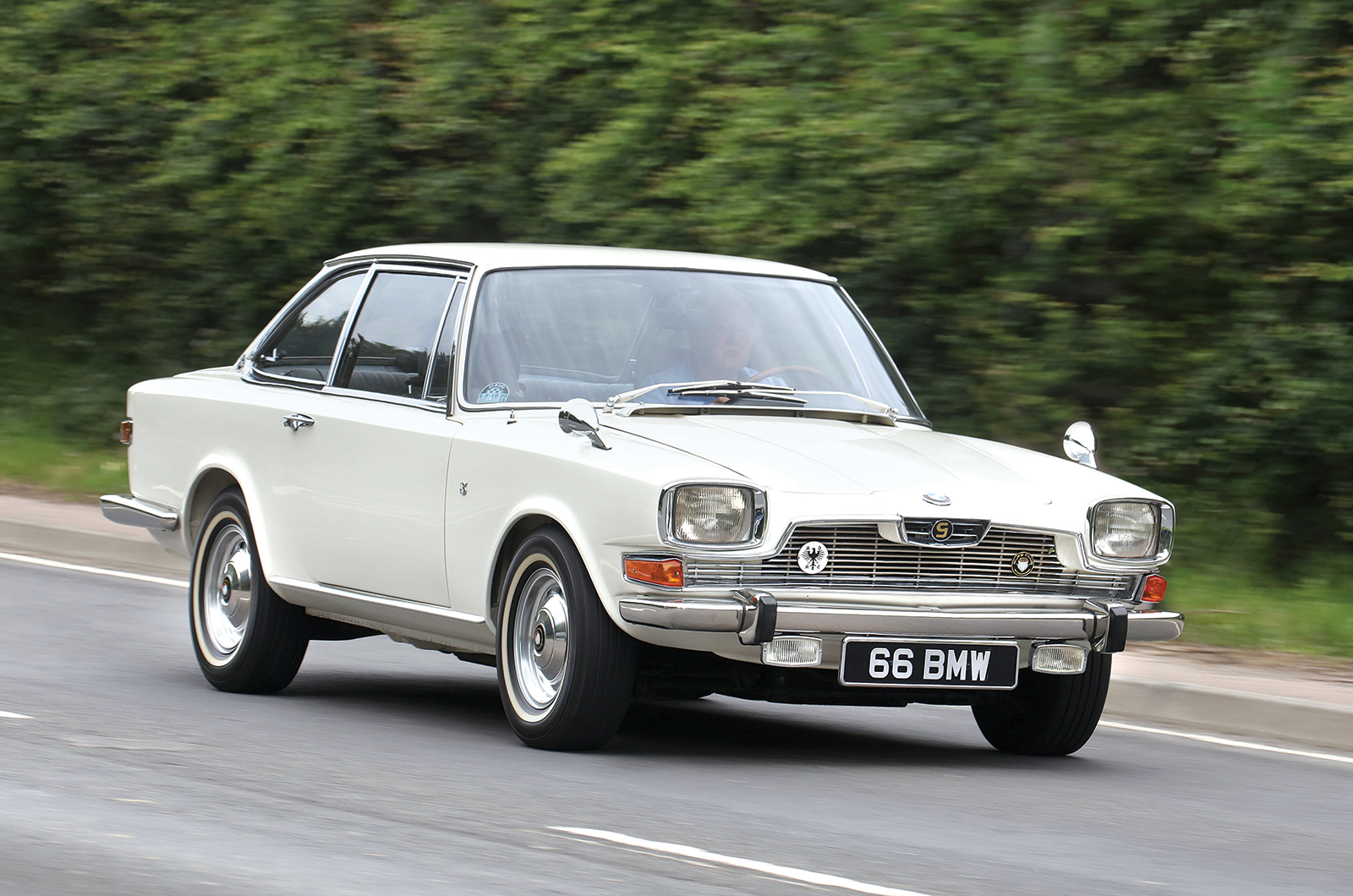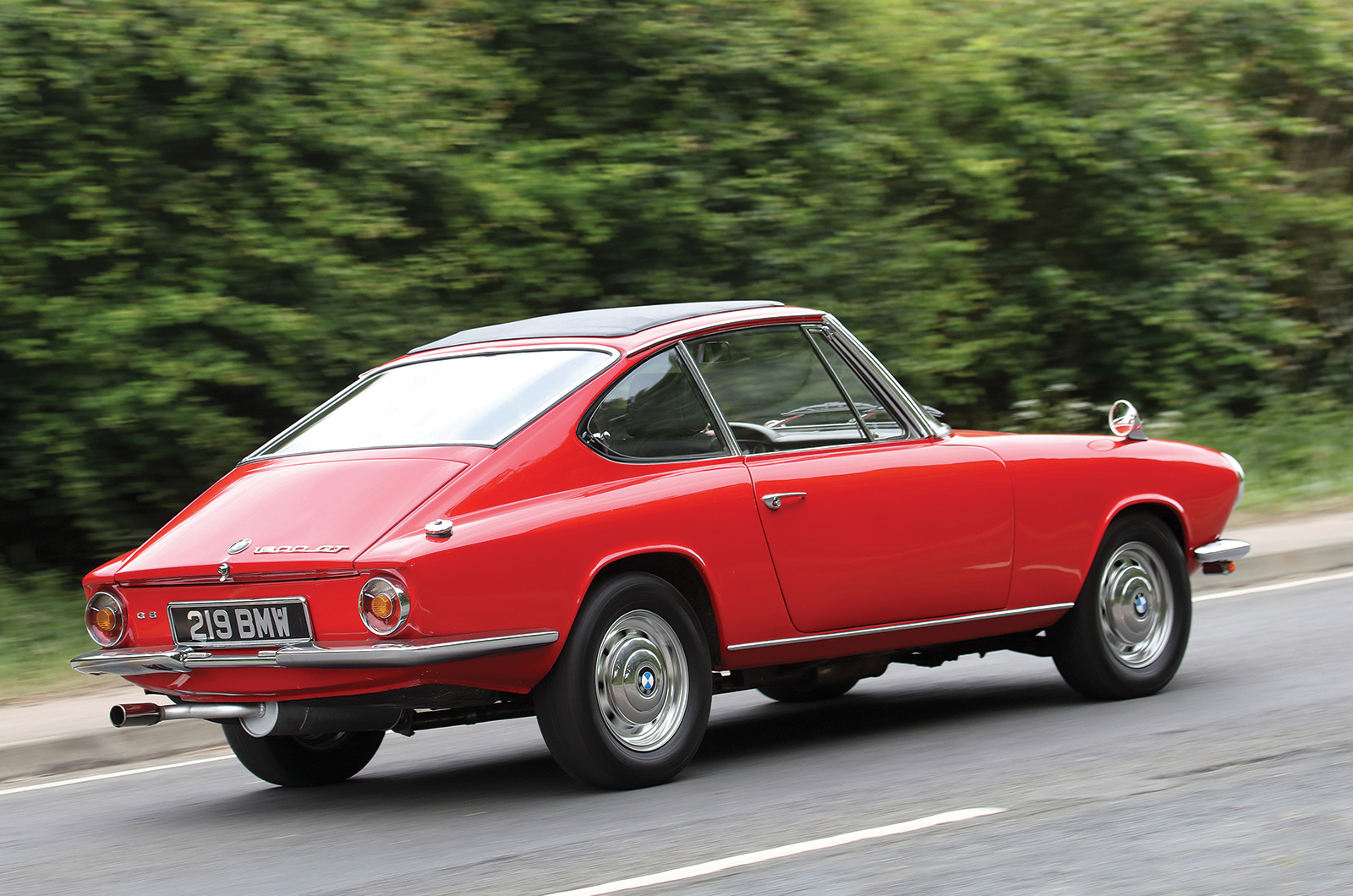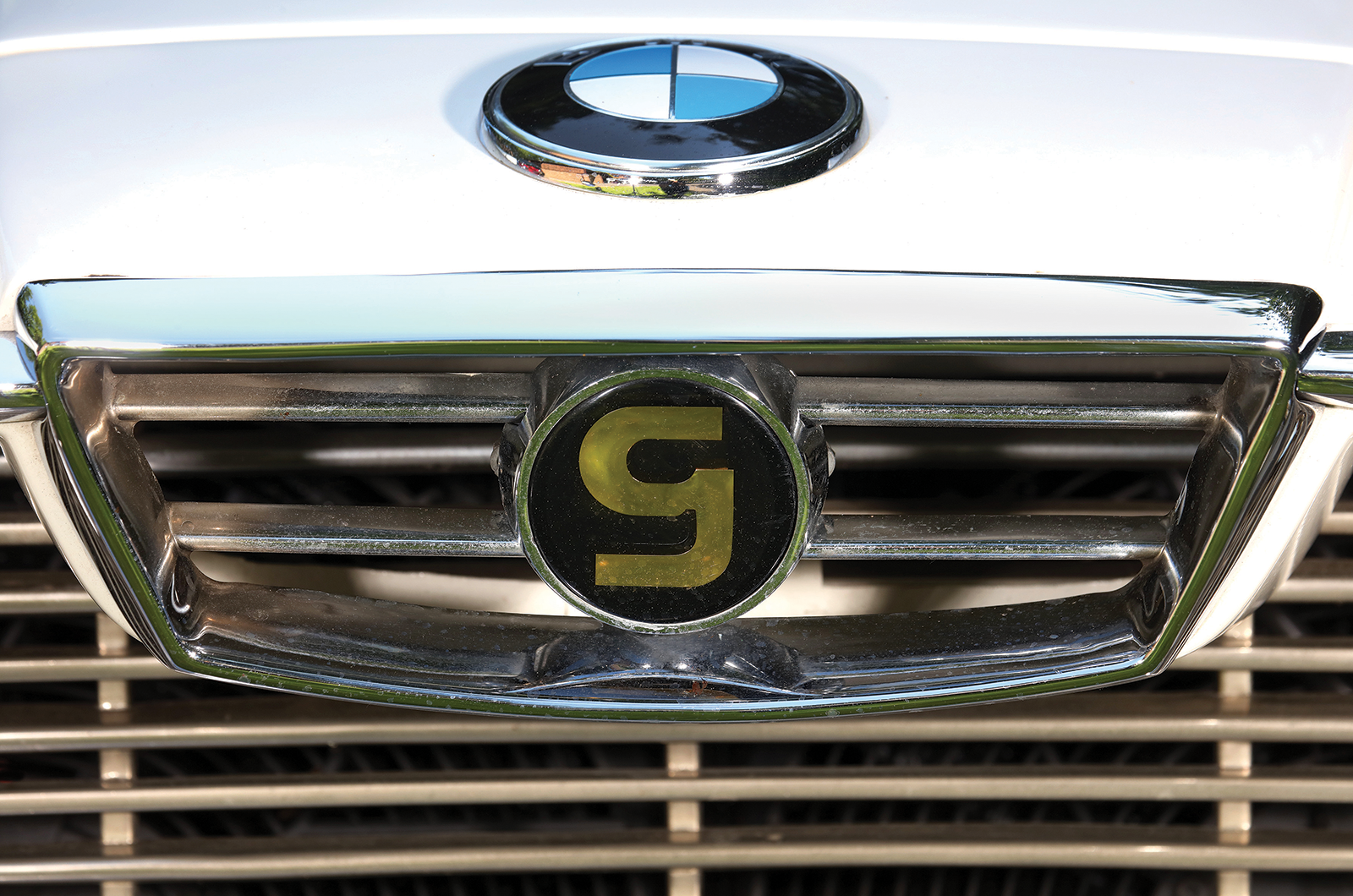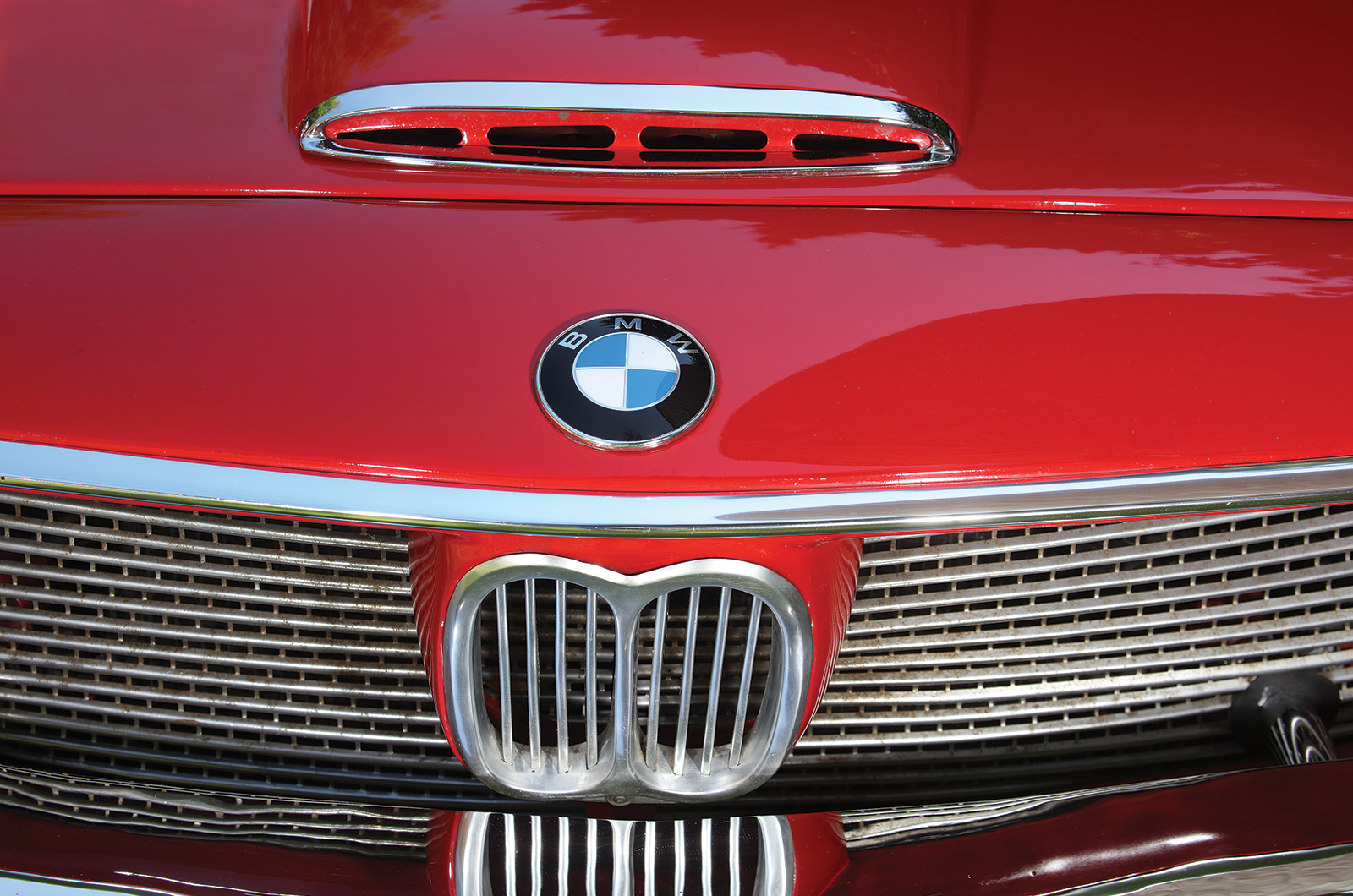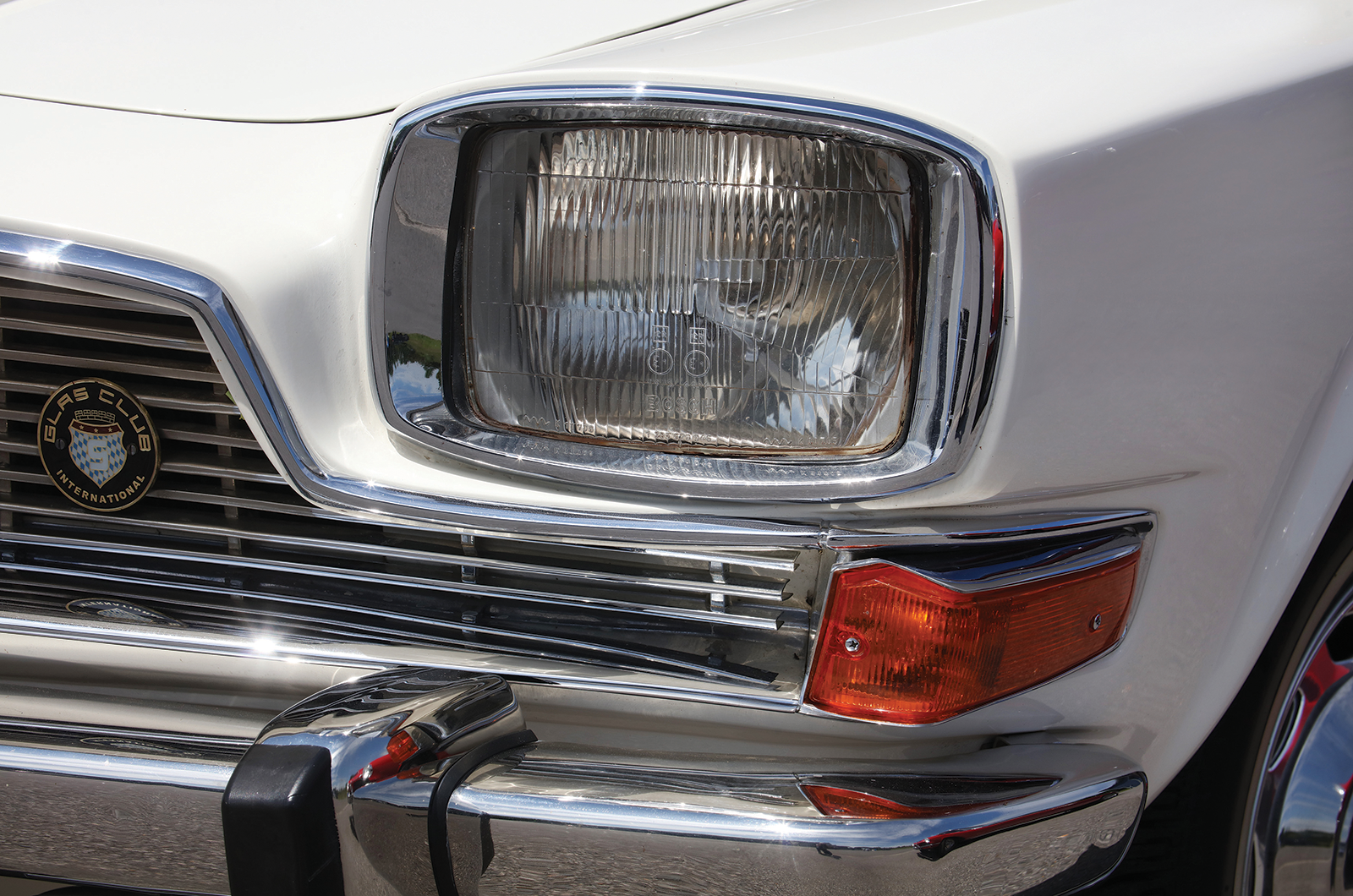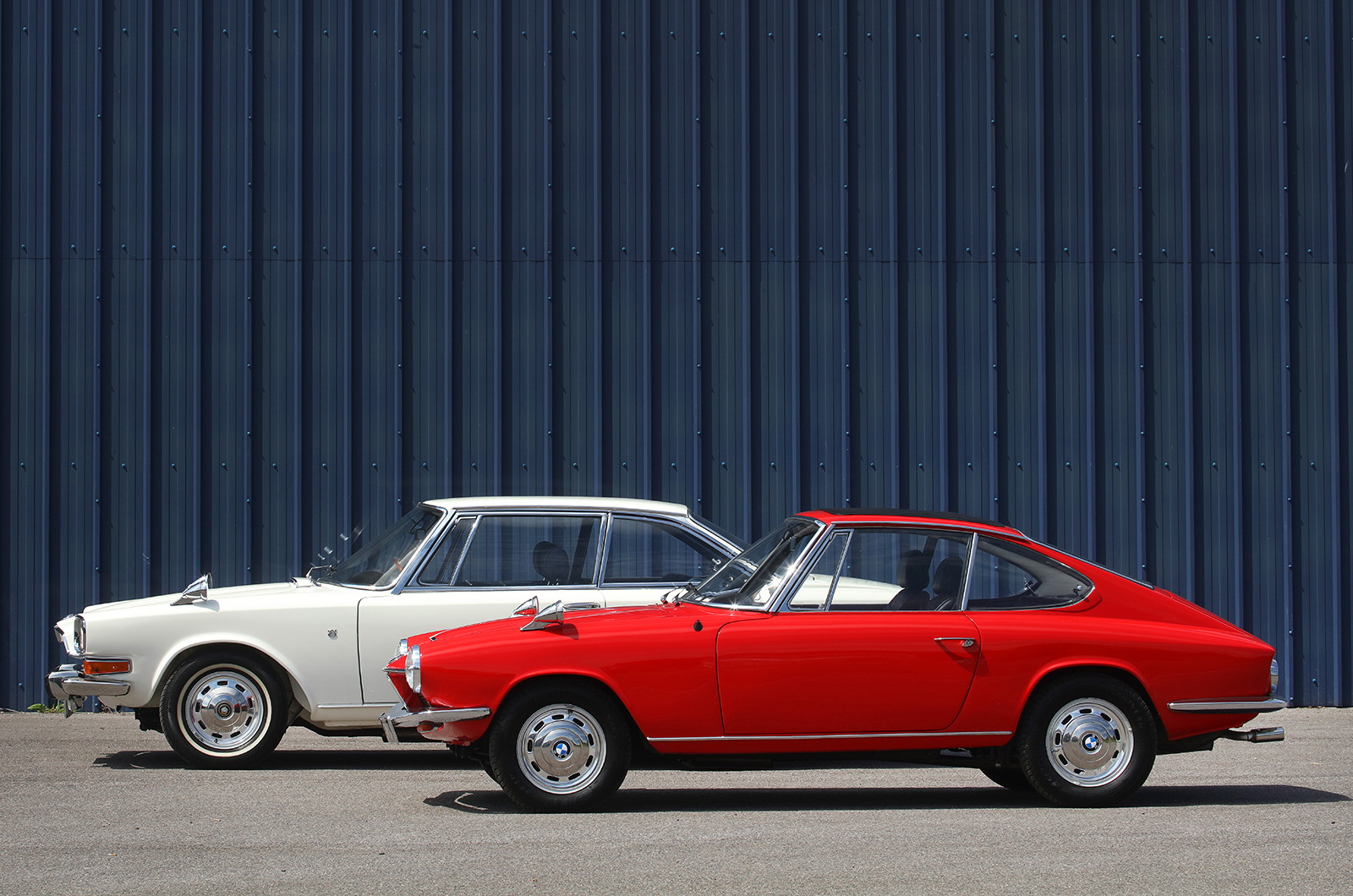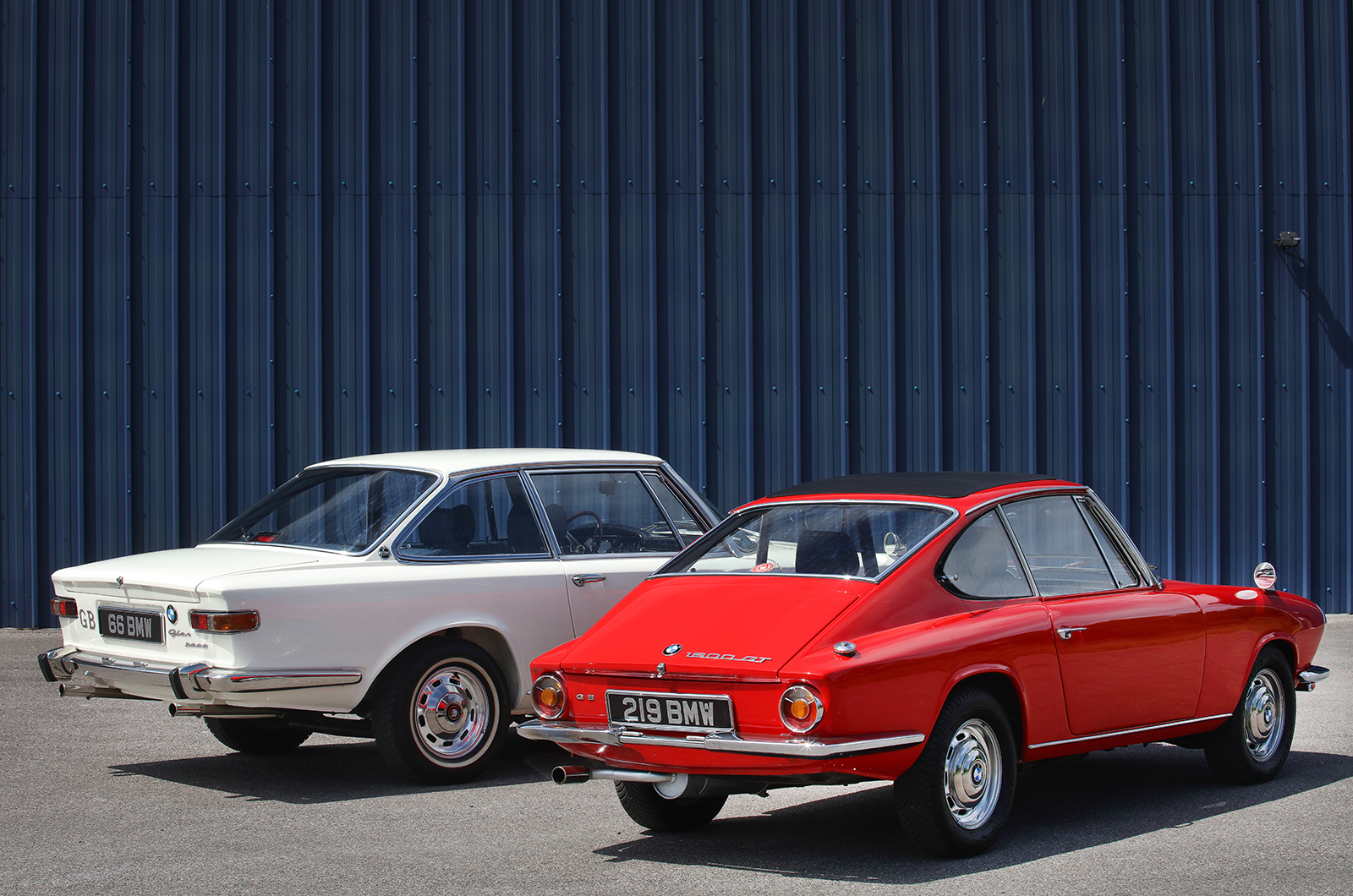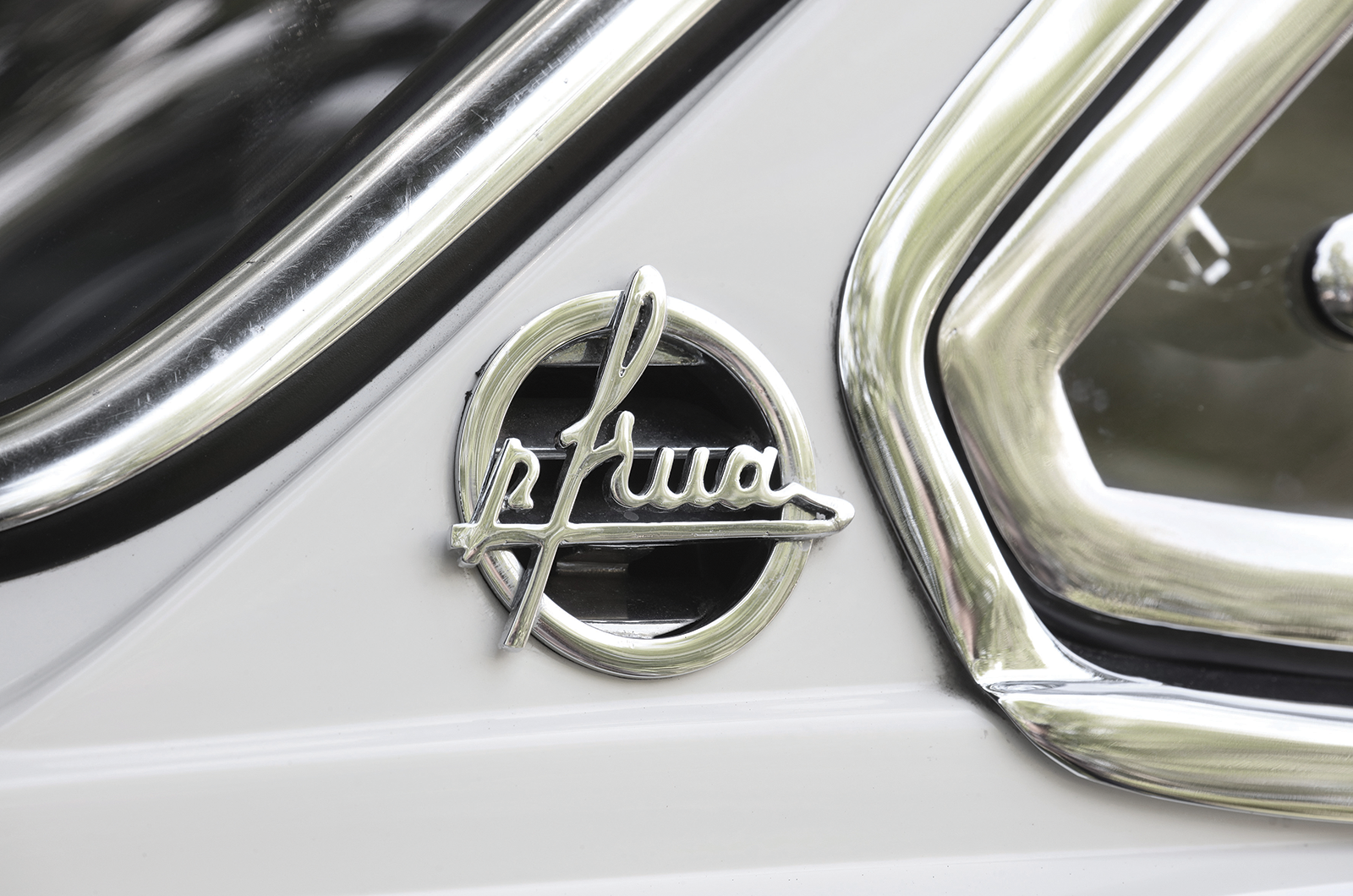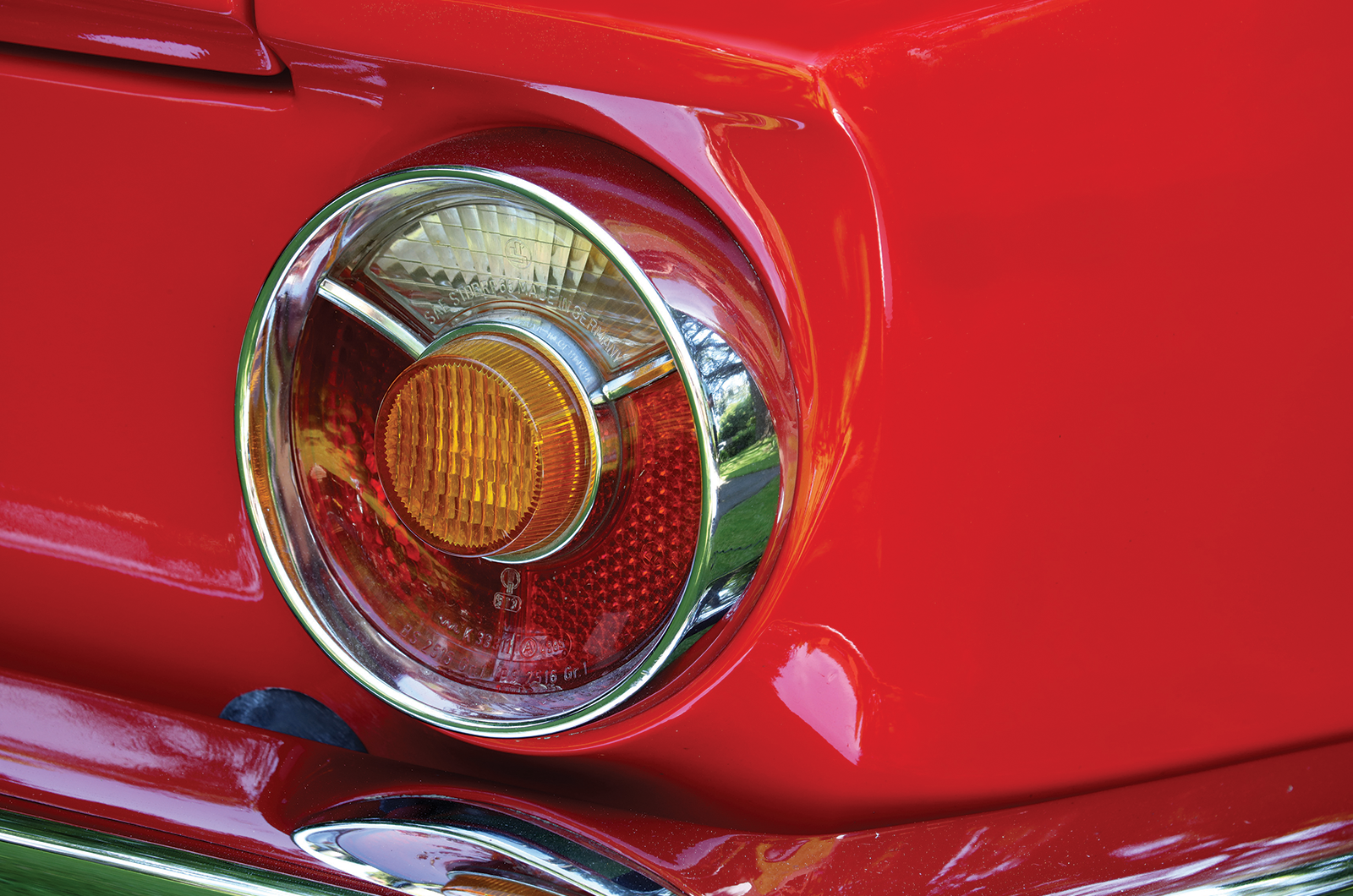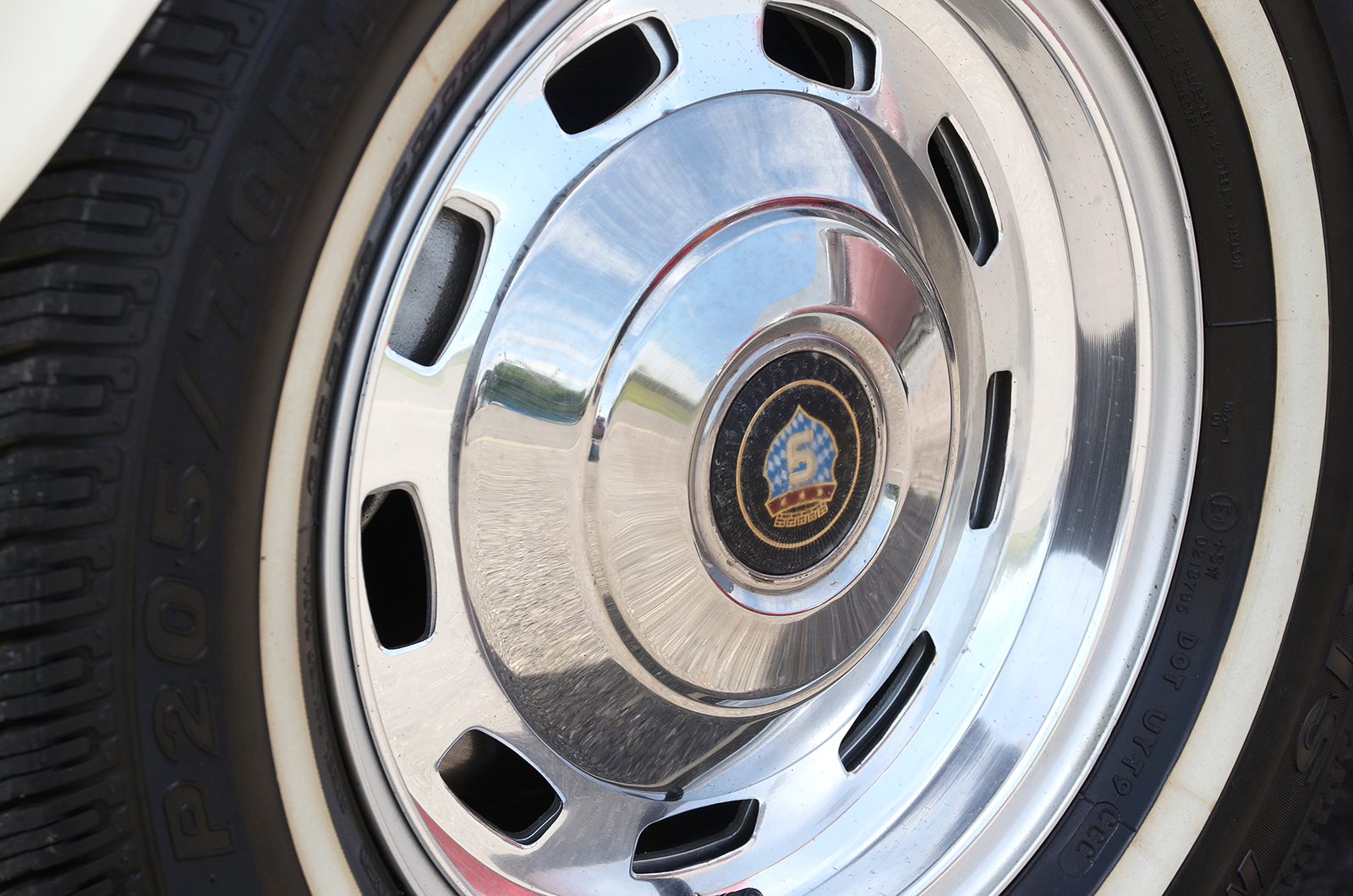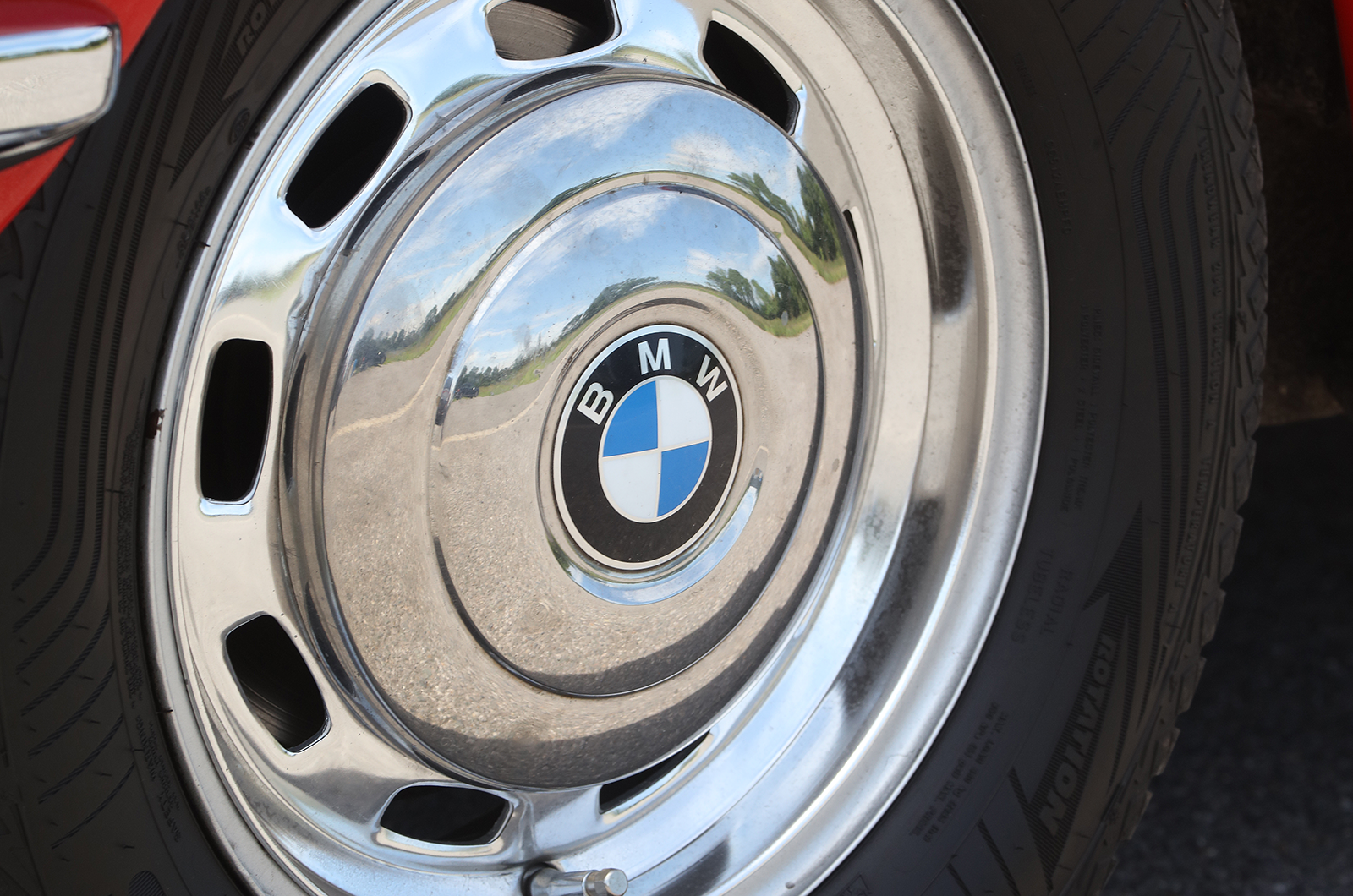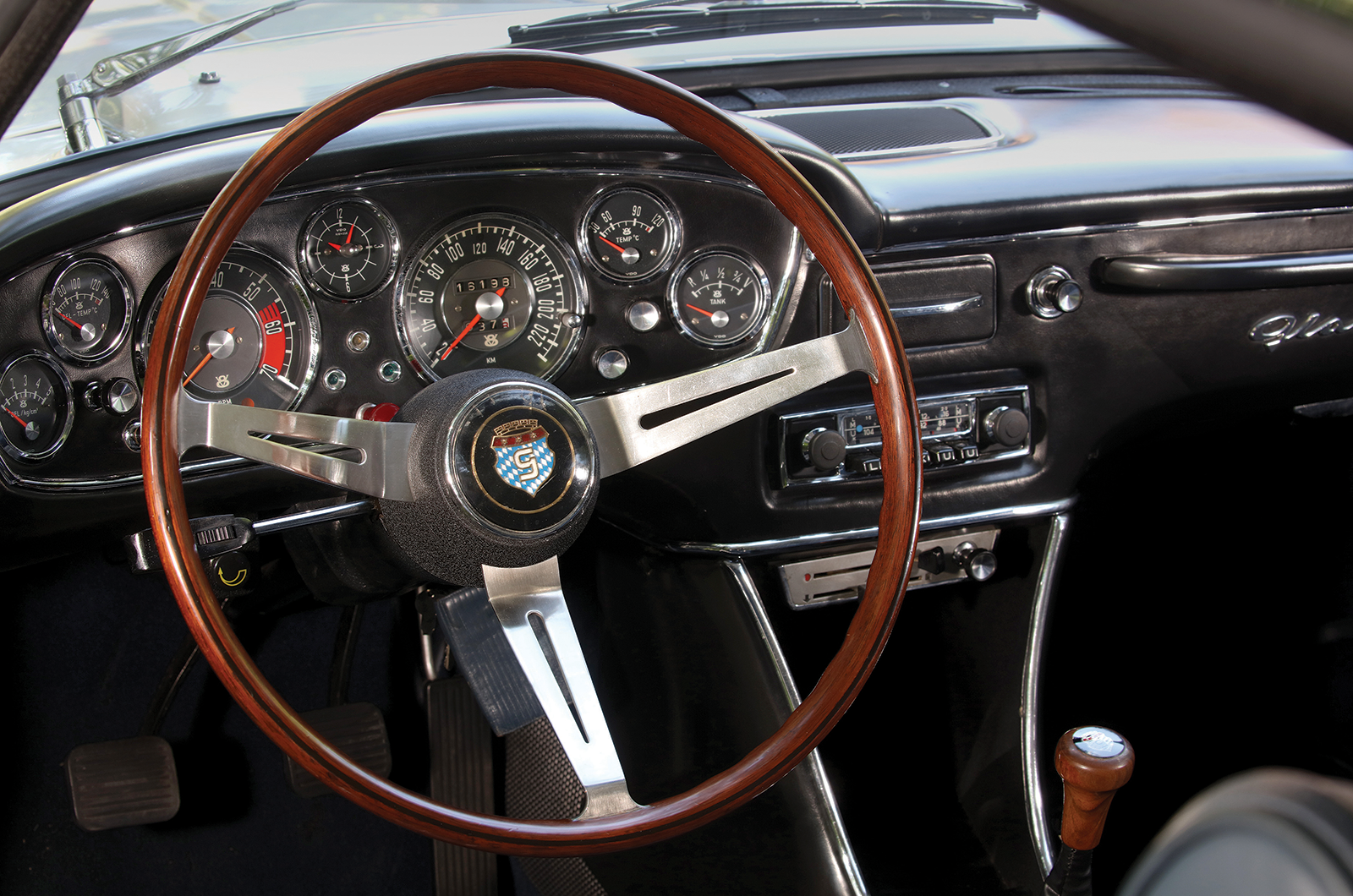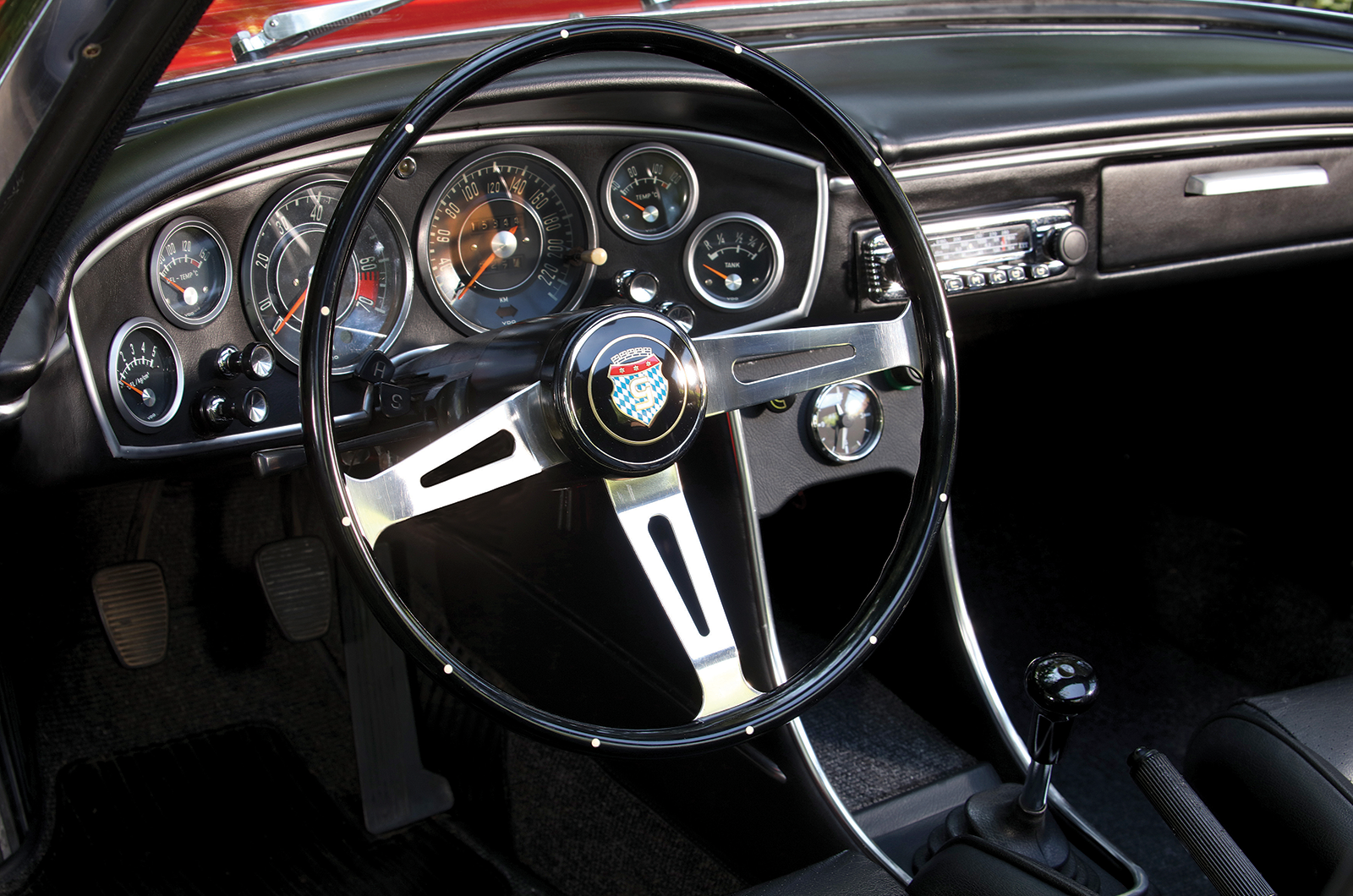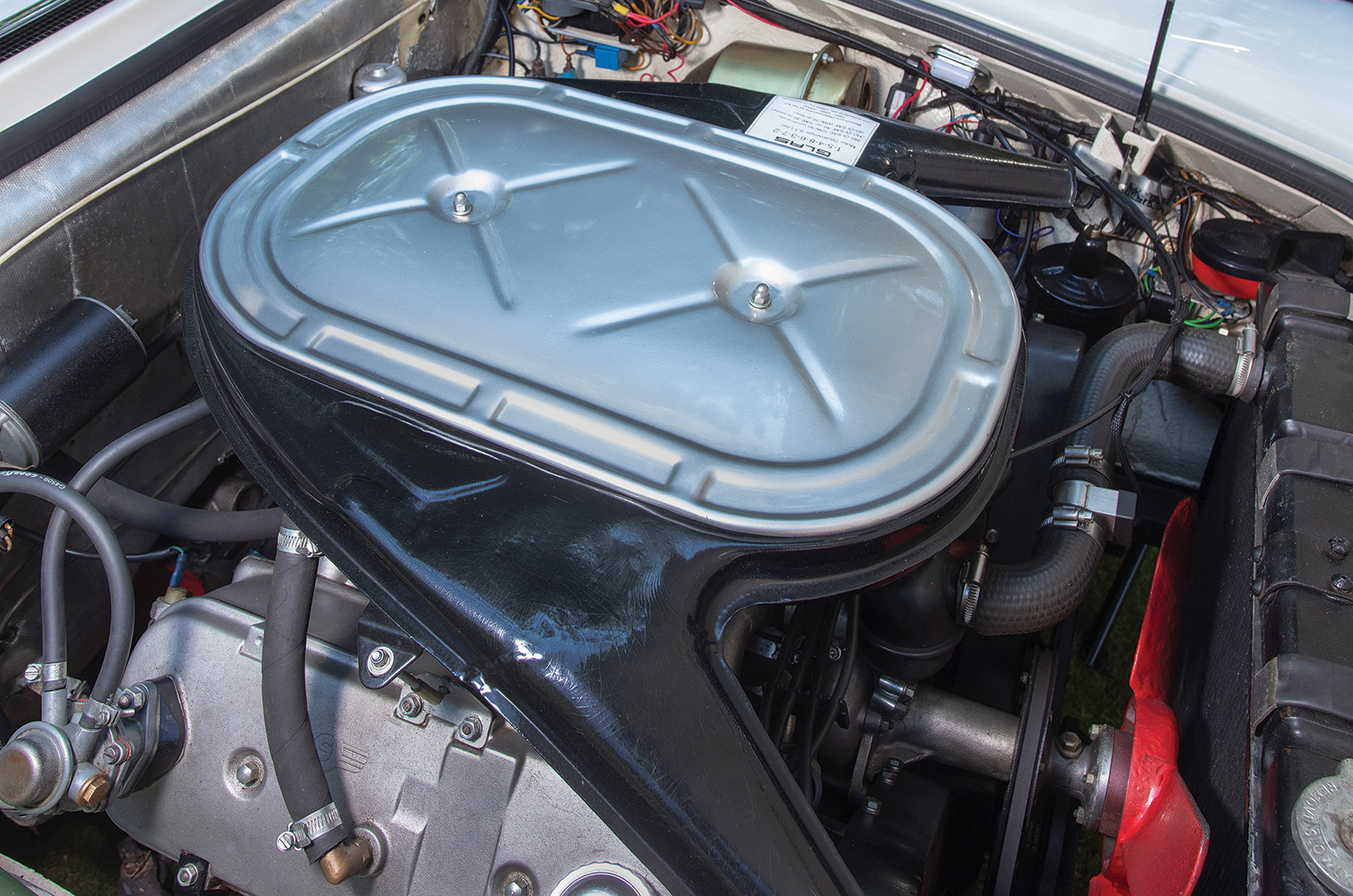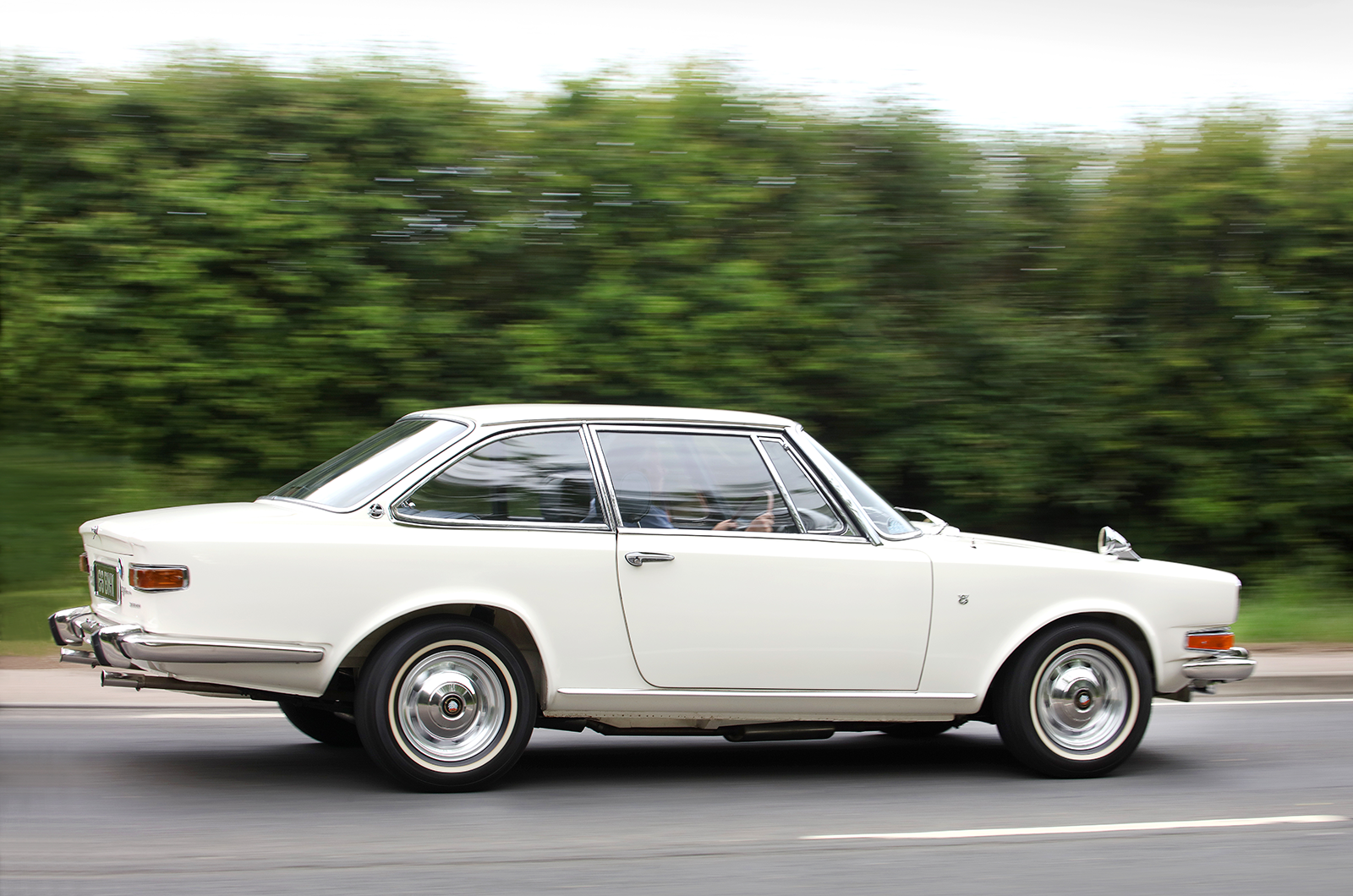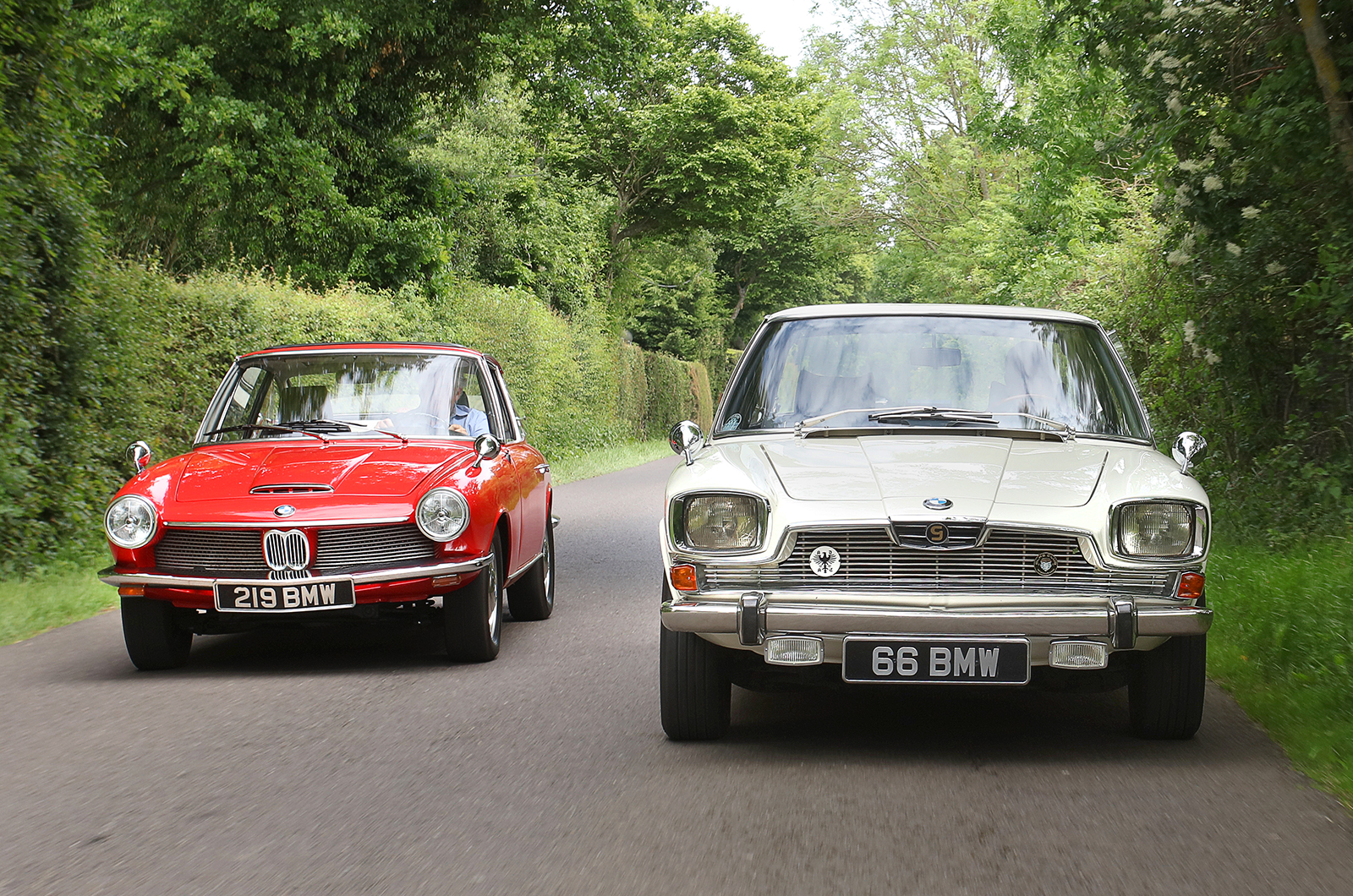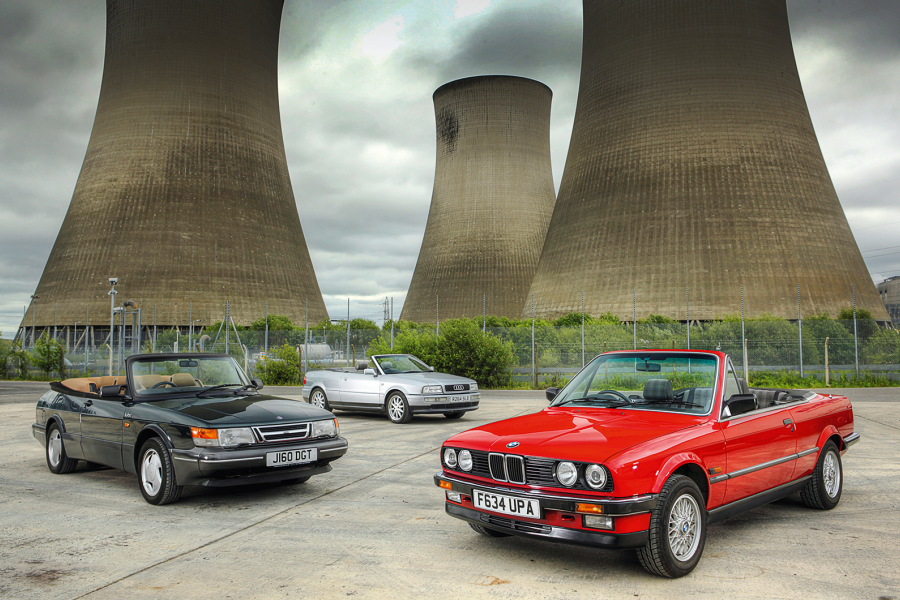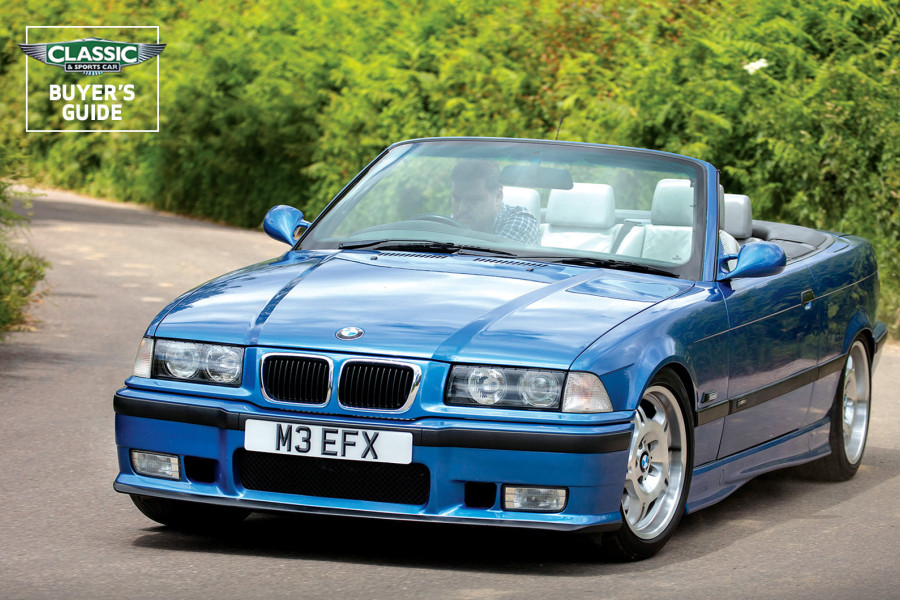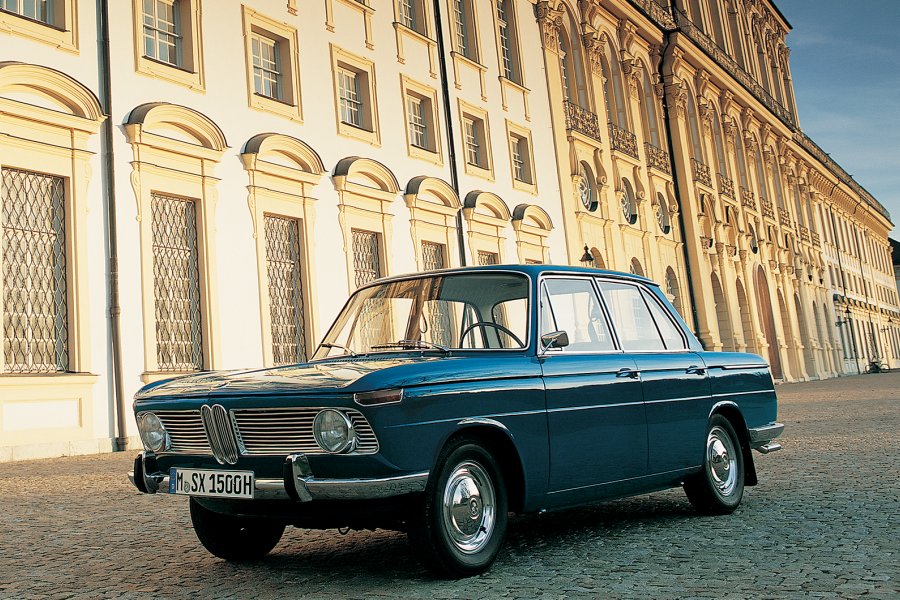Pop the bonnets and, while the nicely finished V8 looks relatively compact, the GT’s canted-over ‘four’ fills the engine bay, the airbox for its Solex carburettors dwarfing the cam cover.
On the V8, Juffs has fitted twin cooling fans and increased the modest capacity of the radiator. Inside, the 2600 is a proper four-seater with room to wear a hat, the 1600 GT more of a two-plus-one.
The cars share big steering wheels, excellent driving positions (with lots of clutch-foot space) and good vision – the low-waisted V8 is a proper goldfish bowl – along with classy-looking dashboards in chrome and leathercloth.
BMW roundel on the 1600 GT’s hubcaps
The bigger car feels like a more polished product in its details, with seven beautifully crafted instruments in a curved layout that is a model of clarity and a joy to behold.
It has conventional pull/twist switches and a multi-function column stalk (from a 230SL) rather than the GT’s unfathomable column-mounted slide controls.
In the driving, points of similarity are hard to find. The 2600 sounds good, but has a slightly uncertain tickover.
The power flows evenly for silky flexibility, making it a lovely car to drive gently, but it lacks the effortless torque you expect of even a small V8.
The Glas 2600 V8’s cabin befits a quality Continental gran turismo
Acceleration through the well-paced, smooth-shifting Getrag gears is brisk and gentlemanly rather than exciting, with little in reserve for tyre-smoking off the mark.
When tickling along, the overhead-cam V8 operates on the centre carburettor, bringing the front and back chokes in progressively as you squeeze harder on the throttle.
You sense that the 5500rpm redline is there to be observed, yet the pull smooths out nicely between 2000 and 4000rpm and, once under way, you are often moving more quickly than you imagine.
The BMW-Glas 1600 GT’s dashboard apes that of the larger car
The V8 has a firm-to-hard and sometimes crashy ride, but would be surprisingly quiet were it not for the high-pitched wind whistle around the driver’s quarterlight.
But the commanding view, the comfortable driving position and the flat, neutral cornering give the car a suave charm that transcends your hooligan instincts.
Juffs’ power-steering conversion is easy to paw around at low speeds – with acceptable ‘feel’ as they climb – making this flagship/swansong Glas less of a chore than it might have been.
The triple-carb V8 majors on smoothness over power in the Glas 2600 V8
The feisty 1600 GT is as aggressive as the V8 is laid-back, with highly strung power delivery that makes it feel – and sound – quicker than it really is.
With its remarkably heavy low-speed steering, poor lock and sharp clutch it demands attention and physical effort.
It is driveable enough at low speeds, but asks that you are in the right gear with a sharply defined point in the peaky torque characteristics where the difference between soaring revs or a flat-spot the size of a cricket pitch is hard to modulate at times.
The BMW-Glas 1600 GT’s twin-carb ‘four’ is peaky and urgent
Keeping the revs up is the best policy, and not a problem with such a rewarding gearchange – although it shares the vice of a weak detent between first and reverse with the bigger car.
At first it doesn’t seem to handle as well as the V8, until you learn to drive it through corners. With a clear line of sight, you can squeeze the throttle and take the line of least resistance against sharpening turn-in.
Squatting hard on its rear suspension, the 1600 GT tells you that it wants to be driven with a certain gusto, all those extra chokes giving it an exciting aural edge over lesser BMW ‘fours’ of the same vintage.
‘The one-upmanship possibilities of a V8 were obvious, particularly if the newcomer could be coaxed to 200kph’
While the likeable V8 feels as if it never quite found its mojo, there is an engaging sense of fun about the GT: a get-up-and-go that makes Juffs’ fondness easy to understand.
A handful of open 1600s were made, which can only have added to the feeling that this pretty car was not so much an alternative Porsche as a German Alfa Romeo.
With more development, the Glas V8 could have been a great car. Today it’s an intriguing oddity, but one that most people in the market for an intriguing oddity won’t even have heard of.
Images: James Mann
Thanks to: Graham Juffs
Factfiles
Glas 2600 V8
- Sold/number built 1965-’68/657 (including BMW-Glas 3000 V8)
- Construction steel monocoque
- Engine iron-block, alloy-heads, sohc-per-bank 2580cc V8, three Solex carbs
- Max power 150bhp @ 5600rpm
- Max torque 152Ib ft @ 3000rpm
- Transmission four-speed manual, RWD
- Suspension: front independent, by double wishbones rear de Dion axle, radius arms; coil springs, telescopic dampers f/r
- Steering worm and roller
- Brakes discs
- Length 15ft 1in (4597mm)
- Width 5ft 9in (1753mm)
- Height 4ft 7in (1397mm)
- Wheelbase 8ft 2½in (2502mm)
- Weight 2976Ib (1350kg)
- 0-60mph 11 secs
- Top speed 121mph
- Mpg 20
- Price new £3046
- Price now £85,000*
BMW-Glas 1600 GT
- Sold/number built 1967-’68/1298
- Construction steel monocoque
- Engine iron-block, alloy-head, sohc 1573cc ‘four’, twin Solex carbs
- Max power 104bhp @ 6000rpm
- Max torque 97Ib ft @ 4500rpm
- Transmission four-speed manual, RWD
- Suspension independent, at front by double wishbones rear semi-trailing arms; coil springs, telescopic dampers f/r
- Steering worm and roller
- Brakes discs front, drums rear
- Length 13ft 3¼in (4045mm)
- Width 5ft 1in (1549mm)
- Height 4ft 2½in (1283mm)
- Wheelbase 7ft 7½in (2324mm)
- Weight 1830Ib (830kg)
- 0-60mph 10.8 secs
- Top speed 118mph
- Mpg 30
- Price new DM15,850
- Price now £55,000*
*Prices correct at date of original publication
Enjoy more of the world’s best classic car content every month when you subscribe to C&SC – get our latest deals here
READ MORE
Putting Munich on the map: BMW 2002 and 3.0 CSL
Natural brawn thrillers: Mercedes-Benz SLK32 AMG vs BMW Z3 M Roadster
BMW E24 M635CSi vs E28 M5: dial M for more
Wild bunch: Saab 99 vs Porsche 911 vs BMW 2002
Martin Buckley
Senior Contributor, Classic & Sports Car
